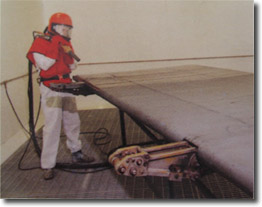 This
rule applies to your facility if you use chemical strippers that contain methylene
chloride (MeCl) to remove dried paint (including, but not limited to, paint, enamel,
varnish, shellac, and lacquer) from wood, metal, plastic, and other substrates.
This rule does not apply to your facility if you do not use strippers that contain
MeCl. This rule also does not apply to paint stripping performed by individuals
on their personal vehicles, possessions, or property, either as a hobby or for maintenance
or if done for others without compensation.
This
rule applies to your facility if you use chemical strippers that contain methylene
chloride (MeCl) to remove dried paint (including, but not limited to, paint, enamel,
varnish, shellac, and lacquer) from wood, metal, plastic, and other substrates.
This rule does not apply to your facility if you do not use strippers that contain
MeCl. This rule also does not apply to paint stripping performed by individuals
on their personal vehicles, possessions, or property, either as a hobby or for maintenance
or if done for others without compensation.
How Do I Comply?
You must complete and submit an Initial Notification Form and Notification of Compliance Status Form to the USEPA and this Department. You must also follow management practices outlined below.
Management Practices:
Paint stripping operations that use less than one ton of MeCl annually must implement “Best Management Practices” to minimize evaporative emissions of MeCl. At a minimum you must:
- Evaluate each application to ensure there is a need for paint stripping;
- Evaluate each application using MeCl to ensure there is no alternative technology that can be used. Alternative technologies include: using paint strippers without MeCl, mechanical stripping, blasting, or thermal and cryogenic decomposition;
- Reduce exposure of paint strippers containing MeCl to the air;
- Optimize application conditions to reduce evaporation (e.g., maintaining low temperatures to reduce evaporation when the stripper is heated); and
- Practice proper storage and disposal of paint strippers (e.g., store in closed, air-tight containers).
Paint stripping operations that use more than one ton of MeCl annually must:
- Develop and implement a written MeCl Minimization Plan to minimize the use and emissions of MeCl. The plan must address the five management practices listed above;
- Post a placard or sign outlining the MeCl minimization plan in each area where paint stripping using MeCl occurs;
- Maintain a copy of the current MeCl Minimization Plan on site at all times; and
- Review the plan every year and evaluate new methods of stripping, and keep records of the review and changes made to the plan.
Paint & Surface Info
- Paint & Surface Home
- Paint Stripping Operations
- Vehicle and Mobile Equipment Coating Operations
- Auto Body Shops - Other Miscellaneous Surface Coating Operations









